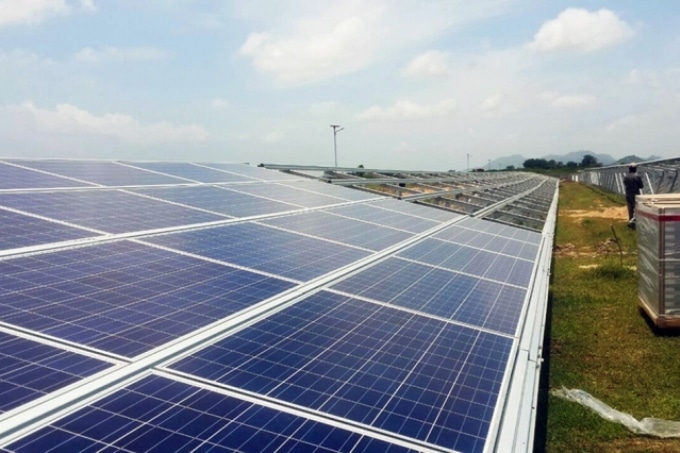Aug 1 2019
The steep growth of the Indian economy has led to an increase in electric power consumption like never before. The installed electricity capacity of the country, which increased by five times in the last 30 years, is anticipated to increase by three times over the next two decades.
 Haloe Energie solar photovoltaic plant in Andhra Pradesh, India. (Image credit: Penn State)
Haloe Energie solar photovoltaic plant in Andhra Pradesh, India. (Image credit: Penn State)
At the same time, India intends to reduce the growth in its carbon dioxide emissions; its Paris Agreement climate promise is to minimize its carbon dioxide emissions intensity of GDP (CO2 emissions per unit of GDP) by 33%–35% by 2030 from the 2005 levels, as well as to promote carbon-free power to around 40% of installed capacity in 2030.
Is it possible for India to reach its climate goals without negatively affecting its rate of economic growth—now estimated at 7% per annum—and what policy strategy would be most effectual in realizing that target?
To answer these questions, scientists from the MIT Joint Program on the Science and Policy of Global Change created an economy-wide model of India with energy-sector detail, and implemented it to replicate the achievement of each constituent of the nation’s Paris pledge.
By denoting the emissions intensity target with an economy-wide carbon price and the installed capacity target with a Renewable Portfolio Standard (RPS), they evaluated the economic implications of three policy scenarios—an RPS, carbon pricing, and a combination of carbon pricing with an RPS. The study outcomes have been reported in the journal Climate Change Economics.
As a stepping stone, the scientists determined that just enforcing an economy-wide emissions reduction policy to achieve the target emissions intensity, replicated through a carbon price, would bring about the lowest cost to India’s economy. This strategy would result in emissions reductions in the electric power sector as well as all through the economy.
On the contrary, they identified that an RPS, which would impose a minimum level of presently more expensive carbon-free electricity, would have the highest per-ton cost—over 10 times higher than the economy-wide CO2 intensity policy.
In our modeling framework, allowing emissions reduction across all sectors of the economy through an economy-wide carbon price ensures that the least-cost pathways for reducing emissions are observed.
Arun Singh, Study Lead Author and Energy Specialist Consultant, World Bank
Singh continued, “This is constrained when electricity sector-specific targets are introduced. If renewable electricity costs are higher than the average cost of electricity, a higher share of renewables in the electricity mix makes electricity costlier, and the impacts of higher electricity prices reverberate across the economy.”
Arun Singh is an ex-research assistant at the MIT joint program and graduate student at the MIT Institute for Data, Systems and Society’s Technology and Policy Program.
However, by integrating an economy-wide carbon price with an RPS, the price per ton of CO2 would be brought down from $23.38/tCO2 (in 2011 U.S. dollars) under a standalone carbon-pricing policy to a far more politically feasible $6.17/tCO2 when an RPS is included.
If solar and wind costs drop considerably, the cost to the economy would reduce significantly; at the least possible wind and solar cost levels simulated, the model estimates that economic losses under a carbon price with RPS would only be somewhat higher than those under a standalone carbon price.
Therefore, falling wind and solar costs could allow India to establish more ambitious climate policies in the upcoming years without considerably hindering economic growth.
Globally, it has been politically impossible to introduce CO2 prices high enough to mitigate climate change in line with the Paris Agreement goal. Combining pricing approaches with technology-specific policies may be important in India, as they have elsewhere, for the politics to work.
Valerie Karplus, Co-Author and Assistant Professor, MIT Sloan School of Management
The economy-wide model of India, designed by Singh together with his master’s thesis advisors at MIT (Karplus, and MIT Joint Program Principal Research Scientist Niven Winchester, who also co-authored the study), allows scientists to estimate the cost-effectiveness and efficiency of various technology and policy choices designed to transform the country to a low-carbon energy system.
The study provides important insights about the costs of different policies, which are relevant to nations that have pledged emission targets under the Paris Agreement but have not yet developed policies to meet those targets.
Niven Winchester, Senior Fellow, Motu Economic and Public Policy Research
The work was supported by the MIT Tata Center for Technology and Design, the Energy Information Administration of the U.S. Department of Energy, and the MIT Joint Program.